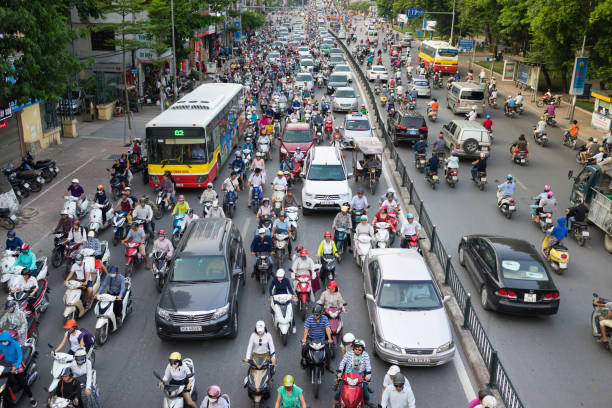Starting from early 2025, Hanoi will pilot a program to restrict polluting vehicles in 5 areas, aiming to completely phase out motorcycles in all districts by 2030. This initiative is a significant step towards a cleaner and healthier Hanoi.

Hanoi is currently finalizing a draft resolution entitled "Regulations on Criteria, Conditions, Procedures for Determining Low Emission Zones in Hanoi." This resolution defines a Low Emission Zone (LEZ) as a restricted area within the city with high levels of air pollution.
According to the latest research, transportation emissions account for approximately 56% of Hanoi's air pollution, including both road dust and exhaust gasses. Of this, emissions of PM2.5 particulate matter and volatile organic compounds (VOCs) primarily originate from diesel-powered trucks and motorcycles. Notably, VOC emissions from motorcycles account for up to 90% of the total.
According to the draft, a low emission zone is a designated area within a city with high levels of air pollution. Vehicles operating in these zones must meet stringent emission standards; non-compliant vehicles will be restricted or subject to fees. To achieve this goal, Hanoi has identified specific low emission zones where strict traffic restrictions will be implemented. Consequently, the 12 inner-city districts of Ba Đình, Hoàn Kiếm, Đống Đa, Hai Bà Trưng, Thanh Xuân, Cầu Giấy, Hoàng Mai, Tây Hồ, Long Biên, Bắc Từ Liêm, Nam Từ Liêm, and Hà Đông are slated to become the first pilot areas for low emission zones.
Restrict pollution in 5 areas
1. Areas with concentrated economic, cultural, and social activities: These areas typically have high population densities and include heritage sites or areas with potential for cultural and social tourism development.
2. Areas with significant air pollution from transportation sources.
3. Areas with infrastructure suitable for low-emission public transportation and the capacity for efficient, convenient, and scientific traffic management.
4. Areas capable of implementing stricter vehicle emission standards: These areas must have effective monitoring and enforcement systems for emission violations, as well as solutions for vehicle conversion and traffic organization to ensure smooth traffic flow.
5. Areas where there is a consensus between the government and residents to establish a low-emission zone: At least 51% of residents must support this initiative
Implementation Roadmap
-
2025-2030: The city will select a pilot area in Hoan Kiem district, evaluate its effectiveness, and then expand the initiative to other districts and counties.
-
2031-2035: The city will encourage districts and counties to establish low-emission zones, and from 2036 onwards, all areas with air pollution will be required to invest resources and ensure the necessary conditions for implementation.
Implementation Plan
At the upcoming December session, the Hanoi People's Committee will submit this resolution to the Hanoi People's Council for approval. If approved, the city plans to pilot the low-emission zone program in 2025, starting with the Hoan Kiem Lake area, its surrounding areas, and the Old Quarter.
Hoan Kiem district is considering selecting the Old Quarter and its vicinity as a pilot area due to several advantages, such as: the existing pedestrian zones on weekends, the presence of numerous historical sites and tourism services, and the need to reduce pollution. Moreover, the area has the potential to connect tourist attractions using green transportation options like electric vehicles and public bicycles.
The pilot program for low-emission zones and restrictions on polluting vehicles will be implemented in early 2025, with a complete ban on motorcycles by 2030.
GIANT BARB SCIENCE AND ENVIRONMENT JOINT STOCK COMPANY
📞 Hotline: +84 995 206 666
✉️ Email: info@giantbarb.com
🏢 Headquarter: No.07 Ton That Thuyet, Dich Vong Hau ward, Cau Giay district, Hanoi